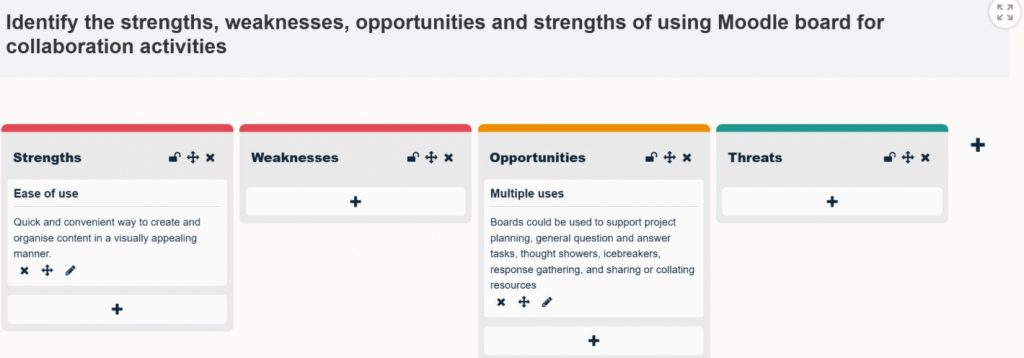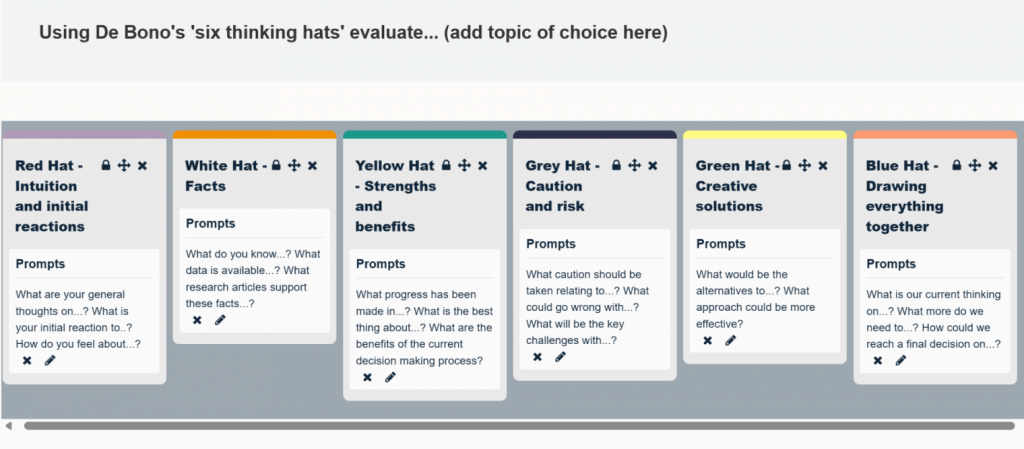July 18, 2023, by Laura Nicholson
Moodle 4.1: Moodle board and the opportunities for teaching and learning
Moodle board introduces new opportunities for interaction, providing students with a versatile tool for sharing ideas and group work. Columns are set up on a virtual board to create a structured framework for students to add their contributions, in the form of post-it notes. The board provides a platform for synchronous and asynchronous activities, featuring a simple yet appealing interface that enhances usability. This blog post will briefly cover getting started with Moodle board, evaluate its potential for teaching and learning, and then conclude with frequently asked questions.
Getting started with Moodle board
To add a board in Moodle 4.1, activate edit mode. Then go to the section you want to add the board and select ‘add an activity or resource’. There you will find the option to add a board.
A quick double-click at the top of the columns on the board enables you to add topic headings. The board is then ready for students to start adding their ideas.
To promote engagement and interest, students are not limited to text-based responses. They can also upload images, YouTube videos and links to web-based resources to their post-it. More detailed guidance on getting started with Moodle board can be found on Workspace under ‘How to add a Board activity’.
Now for a quick overview of the functions of Moodle board, so you can assess how it could align with your teaching practices.
Moodle board for teaching and learning
Opportunities
- Online collaboration space – The board provides a platform within Moodle for students to engage in collaborative activities, without the need to log into any additional external resources.
- Anonymous responses – Anonymity can reduce inhibitions and fears of judgment or criticism, encouraging students to express their thoughts and opinions freely. Students who may be hesitant to contribute openly may feel more comfortable sharing their ideas when their responses are anonymous.
- Variety in response types – Students are not just limited to text-based responses. They can upload images and any online resource, such as podcasts, research articles or YouTube videos.
- Versatility – Moodle boards have been used for project planning, SWOT analysis, icebreakers, question and answer-based tasks, sharing and comparing evidence from research studies, and quick response activities.
Limitations
- Posts are not updated real-time – The board does not automatically update when someone posts, so the page will need manually refreshing to see the latest posts when running synchronous activities.
- Limited opportunity for detail – Moodle board does not lend itself to in-depth, detailed responses due to the 250-word character limit. Whilst this does prevent the board from becoming too cluttered, I agree it could be seen as a limitation as it restricts the potential for detail. However, careful structuring of the activity could help to get around this issue, ensuring the task is still challenging. Edward De Bono’s six thinking hats framework is an effective technique to add challenge and is argued to be effective in increasing engagement and critical thinking (De Bono, 2009). The framework encourages ideas from different angles, so although responses may be constrained by text limit, adopting the six hats structure could promote higher-order thinking processes.
Final thoughts
Moodle board is a valuable tool for fostering collaboration, organising ideas, and promoting creativity within a user-friendly space. It might have some limitations due to the 250-character constraint on posts, but this does prevent the board from becoming too cluttered. Additionally, careful question design and the opportunity for students to add images and other web-based material to support their ideas will help to promote creativity and variety in responses.
Frequently asked questions
- Can you identify who has created the post-it note?
- Students post-it notes are anonymous. So, unless they add their names to the posts, other students do not know who has posted what. Lecturers can see who has posted by using the export submissions option, which creates a spreadsheet detailing who has posted which content and when.

- Do I have any control over what students post?
- Yes, you have the ability to delete a post-it.
- Is it possible to add comments to post-its?
- Yes, double-clicking any of the post-it notes will enable comments to be added. Additionally, it is possible for students or lecturers to star individual post-its to rank ideas.
- For asynchronous activities, can I set a time limit for responses?
- Yes, there is the option to add a closing date for submissions. Once the board is complete, you can store responses by downloading a copy of the boards contents.
- Moodle board sounds very similar to Padlet; what are the similarities and differences between these two tools?
- Moodle board and Padlet are online collaboration tools enabling students to upload content such as text and images. A key difference is that Moodle board is accessed directly in Moodle. However, Padlet is a standalone tool requiring additional navigation and external login screens. Consequently, Moodle board has significant cost, security and navigation benefits over Padlet. In terms of functionality, Padlet does have slightly more customisation and advanced formatting options than Moodle board.
References
De Bono, E. (2009) Six Thinking Hats. Penguin, London.
Further information
In the upcoming weeks, we will continue to update additional information about Moodle 4.1. Additionally, we encourage you to explore our previous blog posts on Moodle’s new look and an introductory video on key changes.
If you have any further questions, please email learning-technologies@nottingham.ac.uk and the team will get back to you.
No comments yet, fill out a comment to be the first



Leave a Reply